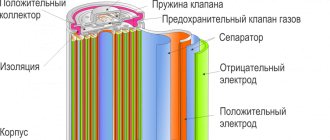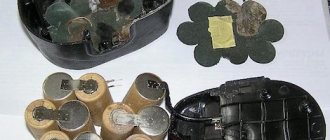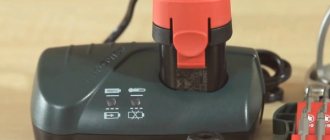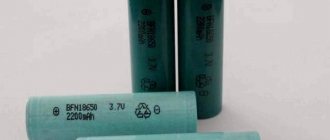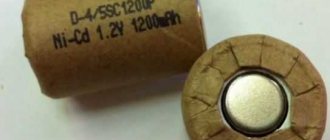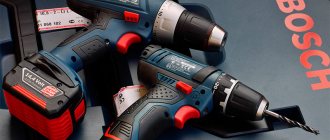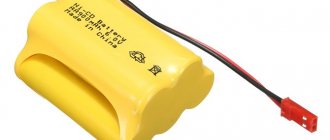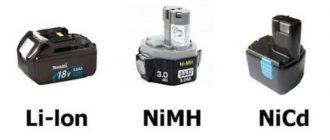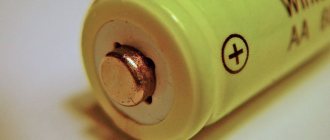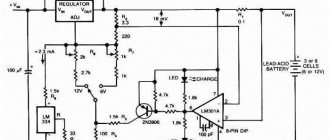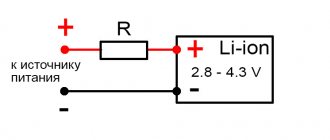16.01.2014
Tools, Electrics
People often write in reviews of a new tool that “the tool itself is good, but the battery died after only six months,” or “I only used it twice, but the battery died.”
The list of similar messages can be continued, but the main point is that people did not really have time to use the tool when something irreparable happened. Moreover, often, purchasing a new battery is either completely impossible (go and find them for some Chinese), or its price turns out to be comparable to buying a new tool. Of course, the tool manufacturer is immediately blamed. However, this is only a small part of his fault.
This short article will help you avoid joining the ranks of “deceived buyers,” and will also tell you what to do if everything has already happened.
Let's start with the main thing - in most cases, the tool manufacturer has nothing to do with the manufacturers of the battery cells found in its battery packs. He simply buys them from those who, in his opinion, offer good value for money. In other words, the battery cells in the batteries for the Bosch tool and some nameless “Chinese” will most likely be from the same manufacturer, for example, the Japanese company Sanyo or Samsung.
The most commonly used battery cells are 18650 size with a typical voltage of 3.6-3.7 V. These cells are universal and are used wherever possible: from laptop batteries to electric vehicles. If we are talking about a 10.8-volt battery for a tool, this means that it contains three such elements. In 14.4-volt - four. In 18-volt - five. In 22-volt there are already six, and so on.
Here is a photo of a 14.4V Hitachi BCL battery without the cover. It can be seen that the base part houses four battery cells (by the way, made by Sanyo), and the control circuit is located in the “leg”.
If the Li-ion battery has died for a long time
So, if trouble has already happened and your battery pack shows no signs of life, then you just need to buy the required number of battery cells of the same type and install them into the unit yourself. A couple of notes: in Russia they are all rare, but you can order from China or the States (Aliexpress.com and Ebay.com will help you) with free delivery at a price of 4-5 dollars per piece; You will also have to remember your soldering skills. In addition, battery cells should not be changed selectively. Just everything at once. After all, the charge controller will consider them all the same, which will lead to overheating of the old ones, which may even catch fire or explode.
And one more thing: the electronics in the battery pack can also be damaged, so before buying new “cans”, first “ring” the old ones. Suddenly everything is fine with them, and it’s not their fault at all.
What needs to be done to make a Li-ion battery last longer than two months
In other words: what to fear from lithium-ion batteries. In household use in power tools, they are afraid of only one thing - long-term storage during deep discharge. When the charge remains less than 10%, the battery begins to degrade quickly. If you completely discharged the battery and forgot to charge it, but remembered about it a couple of months later, don’t blame me. Most likely you will have to buy a new one.
The situation is aggravated by the fact that many power tool manufacturers, for reasons of economy, do not do two things. First, the cheapest tool may not have a system to protect the battery from deep discharge. The second is that if this system is present, it often allows for a deeper discharge than the battery cell manufacturer regulates. This is done to squeeze out every last drop and in such a way that the user will not delay for a long time in installing the battery for charging. In other words, if you have finished work and think that the battery is more than two-thirds discharged, put it on charge.
That's all the wisdom for those who don't want to delve into the details. If you are one of those people, then you don’t need to read any further.
But if you're interested in the details, or if you use the tool regularly, there's still more to tell.
For those who use the tool regularly
There are a few other tips to help you extend the life of your lithium-ion batteries.
1. As mentioned above, always try to immediately charge the battery if it is completely or almost completely discharged. At the same time, avoid deep discharge-charge cycles. This table will show how many charge-discharge cycles will follow before losing 50% of the capacity, depending on the depth of battery discharge:
2. Do not charge batteries in sub-zero temperatures. They will lose capacity.
3. Do not store batteries at temperatures above 30 degrees. This plate shows how much the capacity will decrease depending on the storage temperature and the state of charge of the battery:
4. If the battery will be stored for a long time, do not charge it completely. The optimal charge level would be 35-50%.
How to Store a Screwdriver Battery
How to properly charge a screwdriver
A screwdriver is the most popular tool used by professionals and amateurs. Use is rarely convenient, especially if you are away from two hundred and twenty V. With a cordless tool, this problem is solved; with its help, of course, you can move freely without dragging the cord behind you.
One of the elements of any cordless tool is a battery, which ensures autonomous operation. However, how should the battery be charged correctly so that it lasts as long as possible? Further details on the text of the article.
Screwdriver. How to increase battery life
How to increase battery
.
How to properly discharge and charge a battery
. What will happen to.
As you can see, each battery is endowed with characteristic features, taking into account which you will be able to charge the screwdriver correctly.
Features of charging of one type or another ()
The initial charging of the screwdriver is considered a very significant factor, since it determines whether the full charge capacity becomes active or not.
Any type of battery has its own characteristics of primary charging. The process of recharging a nickel-cadmium battery is somewhat complicated.
It is recommended to completely discharge the nickel-metal hydride type for the first time, and also fully charge it. The complete charging/discharging cycle is repeated 4-5 times, then you can safely charge and discharge the battery regardless of how full the container is.
There are no special rules for lithium-ion; the capacity remains unchanged for a long time.
Advice! The power source must not be allowed to overheat above fifty degrees.
What to do if the battery does not charge? (2)
The reason may lie in either wear or tear of the device. It often happens that the contacts between the terminals of the charger and the battery are broken. Then you can disassemble the “charging” yourself and bend the terminals.
As you know, all contacts oxidize and become dirty over time; this is no exception for a screwdriver. Usually expressed in a significant reduction in charging time, as well as the duration of activity of the power tool. To eliminate the oxide, you need to carefully wipe the contacts with a special substance or, in extreme cases, alcohol.
Very often, nickel-cadmium batteries lose their capacity, especially when it comes to non-professional models. Experienced users prefer to overclock such batteries.
First, the battery pack is disassembled and problem areas are identified. Then they need to be recharged. It is better to immediately use a higher current than expected, and then discharge again.
If the Ni-Cd electrolyte has still not disappeared, the procedure can be resumed.
And some experts even use car chargers to recharge the battery.
Source: https://ctln.ru/kak-hranit-akkumuljator-ot-shurupoverta/
Battery types
In order for the battery to last for years “like a clock,” you first need to follow the instructions included with the device. It must be said that screwdrivers differ not so much in price, power, manufacturer, and are additionally divided into professional and semi-professional. Accordingly, the batteries will also have a different cost, quality and charge capacity.
Professional types are equipped with more capacious power supplies, which will cost more, but they will work longer than usual. Russian manufacturers use different batteries at the production stage of their own devices, each with certain parameters and features that should be taken into account when charging.
Screwdriver batteries are divided into the following types:
1. Lithium-ion lithium
They are considered the most massive batteries. They are quite fast to charge, and in addition they have a complete absence of memory effect. Charging this type of battery is easy.
It is not necessary to recharge it after complete discharge; feed is allowed as long as necessary. The high price and intolerance to low temperatures prevents the desire to buy from others, so they are not needed much. Charge batteries at temperatures between 10 and 40°C.
If the battery gets hot while charging, it needs to be cooled to avoid future damage.
2. Nickel-cadmium Ni-Cd
The nickel-cadmium battery is equipped with small dimensions and low capacity. By following the included instructions, they can be fed over 1000 times. There is a memory effect, if you charge it until it is completely empty, it can reduce the energy capacity.
Before the first use, you need to charge and discharge the battery at least three times. In the future, it is also recommended to completely discharge and charge the device, which will allow you to bring the power to the required operating state.
This rule applies when the instrument is in storage.
3. Nickel metal hydride Ni-MH
Therefore, the memory effect is slightly weaker than the previous version, which is an indisputable advantage. The disadvantage of NMHS is the highest self-discharge current. For a battery to work for a long time, like oil, it must be charged. If the screwdriver is not used for a long time (about a month) the oil should become completely overcharged.
Typical user for a lithium-ion battery
battery life
.
How to properly perform and charge the battery
. What will happen to
Screwdriver. How to Increase Battery Life
In this video I will tell you how to extend the life of your Li-ion battery
and he. You will learn how to
As you can see, each rechargeable battery has its own characteristics, considering that it will be possible to charge the screwdriver properly.
Features of charging of one type or another (video)
The initial charging of the screwdriver is a very important factor as it determines whether the full charge capacity is active or not. Any type of battery has its own characteristics of initial charging. The process of recharging a nickel-cadmium battery is somewhat complex. Initially, it needs to be recharged three times in a row and therefore the charge capacity remains full.
Nickel metal hydride is recommended to be completely discharged for the first time, and also fully charged. The full charge/discharge cycle is repeated 4-5 times, then you can safely charge and discharge the battery, regardless of the capacity of the container.
There are no special rules for lithium-ion, the capacity remains unchanged for a long time.
Advice! Do not overheat the power source above 50 degrees.
What is the optimal time for charging?
The charging period is usually specified in the device's instruction manual. In most cases, the device has a special indicator that helps you understand how long it takes to charge.
When charging is complete, turn it off to avoid damaging the batteries. The average charge for a screwdriver is from 30 minutes to 7 hours.
The longest period of 1.2V Ni-Cd at 250mA is approximately seven hours.
There are also two types of battery chargers: regular and pulse. Standard charging is usually completed with non-professional tools, the charge lasts about 3-7 hours. The pulse device is designed for professional models and can charge the battery for a maximum of 1 hour.
Advice. The Interskol screwdriver is distinguished by its versatility; with the exception of its main function, it can still be used as a drill.
Is it worth charging before long-term storage?
Do not use the screwdriver battery for a long time? Experts give the following recommendations.
- Nickel Cadmium Before storage, the battery must be discharged until the screwdriver no longer functions under full load. For long-term storage, it is necessary to carry out 3-5 rounds of charging/unloading in a circle.
- Nickel hydride provides a higher self-discharge value, unlike previous elements. Experts advise keeping them charged and charging them for the day after a long break. The capacity decreases after 200-300 charge-discharge cycles. For this type, partial discharge is allowed.
- Lithium-ion is completely different from the "memory effect". The battery can be charged at any time. It is not recommended to fully implement them; as a result, you may disable the protection scheme. Equipped with special controllers that turn off the element at high temperatures to prevent overload. You can only save 50% of the product.
What to do if the battery is not charged? (2 videos)
The reason may be covered as if the device is worn out. It often happens that the contacts between the charger terminals and the battery are broken. Then you can disassemble the “charging” yourself and bend the terminals.
As you know, all contacts oxidize and become dirty over time; this is no exception for a screwdriver with a charger. Typically results in a significant reduction in charging time as well as in the duration of activity of electrical tools. To eliminate the oxide, you need to carefully wipe the contacts with a special substance or, in extreme cases, alcohol.
Very often, nickel-cadmium batteries lose their capacity, especially when it comes to non-professional models. Power users prefer overclocking these batteries.
First, the battery is disassembled and problem areas are identified. Then you need to recharge them. It is better to immediately use a higher current than should be, and then discharge again.
If the electrolyte still does not disappear into the Ni-Cd, the procedure can restore power.
And some experts even use charging to charge the battery.
Source: https://vdiweb.ru/kak-hranit-akkumuljator-ot-shurupoverta/
What you need to know about charging lithium-ion batteries
This is a complex process. Each type of battery has its own strategy, but in general terms it is called CC-CV and consists of two main stages - charging with constant current and increasing voltage, then recharging with constant voltage. There may also be additional stages, for example, the whole process may look like this:
1. The battery is first checked electronically to determine its current state and state of charge, as well as its suitability for a fast charge cycle. In the first minutes, a low voltage and low current are applied. If the voltage on the battery does not increase (i.e. it accepts a charge well), then everything is in order, you can charge in fast mode;
2. then comes the main charging phase, which lasts about an hour, where the voltage gradually increases with a consistently high current;
3. then the final phase begins (recharging), where the voltage is kept at the maximum permissible level (usually 4.2 V), and the current gradually decreases. It can last about two hours.
It is extremely important for lithium-ion batteries to prevent overcharging. It also negatively affects the battery life, as does storing it in a discharged state. In addition, the battery can simply overheat and explode. Therefore, the controller strictly monitors this process and stops charging at the appropriate moment.
But unscrupulous manufacturers can cheat a little. If you slightly increase the charge voltage (by 0.1 V, to 4.3 V), this will slightly speed up the process, and most importantly, it will increase the amount of energy stored in the battery by 10%. The consequences of this approach are reflected in this graph:
Please note that the ordinate scale is non-linear, and the graph itself reflects only the number of recharge cycles at which the battery capacity will be halved. And here we see that at a voltage of 4.2 V the battery degrades extremely slowly, and the number of cycles until the capacity “halves” can be about 1000. But if the voltage is increased by only 0.1 V, the degradation rate will increase fourfold.
Ultra fast charging
Typically, the manufacturer recommends charging battery cells with currents equal to 0.7 or 1 of the capacity divided by time (i.e., for a 1500 mAh battery cell, the recommended charge current is 1.5 A). Some manufacturers allow charging at significantly higher currents, which speeds up the process significantly. However, this leads to accelerated degradation of the battery, plus at the same time you have to monitor its temperature and stop the process if the battery heats up to 40 degrees (the exact value is determined by the battery manufacturer). Early overheating is common with aging batteries.
Here is a graph of capacity loss of lithium-ion batteries depending on the magnitude of charge and discharge currents:
The blue line is charging and discharging with currents equal to capacity/time (for 1500 mAh batteries this is 1.5 A). Green – doubled charge and discharge current relative to capacity (for 1500 mAh batteries – 3 A). Red – triple current (for 1500 mAh batteries – 4.5 A).
In other words, fast charging modes will lead to accelerated battery degradation.
How to properly charge a screwdriver
A screwdriver is one of the most popular tools used by professionals and amateurs. Using corded screwdrivers is not always convenient, especially if you are away from 220 V. With a cordless tool, this problem is solved; you can move freely with it without dragging the cord behind you.
- DIY screwdriver charger
One of the main elements of any cordless tool is the battery, which ensures autonomous operation. But how should you charge the battery correctly so that it lasts as long as possible? Further details in the article.
Types of batteries
In order for the battery to serve for a long time “like a clock,” you must first read the instructions included with the device. It should be noted that screwdrivers differ not only in price, power, manufacturer, but are also divided into professional and semi-professional. Accordingly, batteries will also have different prices, quality and charge capacity.
Professional types are equipped with more capacious power supplies, which will cost a level more, but will also work longer than conventional ones. Manufacturers use various batteries in the manufacture of their devices, each of which has certain parameters and features that should be taken into account during charging.
Batteries for screwdrivers can be classified into the following types:
1. Lithium Li-Ion
They are considered the most powerful batteries. They charge fairly quickly, and there is no memory effect at all. Recharging this type of battery is as easy as shelling pears. There is no need to recharge it after it is completely discharged; you can recharge it as needed.
The high cost and intolerance to low temperatures discourage many people from purchasing, so they are not in great demand. Batteries should be charged at temperatures between 10 and 40°C.
If the battery becomes hot during charging, it must be cooled to avoid further damage.
2. Nickel-cadmium Ni-Cd
The nickel cadmium battery has compact dimensions and large capacity. By following the included instructions, they can be recharged more than 1000 times. There is a memory effect; if you charge it before it is completely discharged, this can reduce the energy capacity.
Before first use, you need to charge and discharge the battery at least three times. In the future, it is also recommended to completely discharge and charge the device, this will make it possible to bring the capacity to the required operating condition.
The same rule applies when storing the instrument.
3. Nickel metal hydride Ni-MH
They belong to the newest generation of batteries, for this reason, the memory effect is somewhat weaker than the previous type, which is a definite plus. The disadvantage of NMGB is the highest self-discharge current. In order for the battery to function for a long time, it must be kept charged. If the screwdriver is not used for a long time (about a month), it must be completely recharged.
As you can see, each battery is endowed with characteristic features, taking into account which you will be able to charge the screwdriver correctly.
Features of charging of one type or another + ()
The initial charging of the screwdriver is considered a very significant factor, since it determines whether the full charge capacity becomes active or not.
Any type of battery has its own characteristics of primary charging. The process of recharging a nickel-cadmium battery is somewhat complicated.
It is recommended to completely discharge the nickel-metal hydride type for the first time, and also fully charge it. The complete charging/discharging cycle is repeated 4-5 times, then you can safely charge and discharge the battery regardless of how full the container is.
There are no special rules for lithium-ion; the capacity remains unchanged for a long time.
Advice! Do not allow the power supply to overheat above 50 degrees.
What is the optimal amount of time to charge?
The recharging period is usually indicated in the device instructions. In most cases, the device has a special indicator that helps you understand how long you still need to charge.
Once charging is complete, turn it off to avoid damaging the batteries. The average charging time for a screwdriver will be from 30 minutes to seven hours.
The longest period is for Ni-Cd with a voltage of 1.2 V, feeding with a current of 250 mA for approximately seven hours.
There are also two types of battery chargers: regular and pulse. Standard charging is most often included with non-professional tools; the charge lasts about 3-7 hours. The pulse device is designed for professional models and is capable of powering the battery in a maximum of 1 hour.
Tip: The Interskol screwdriver is distinguished by its versatility; in addition to its main function, it can also be used as a drill.
Should I charge it before long-term storage?
Haven't used your screwdriver battery for a long time? Experts give the following recommendations.
- Before storage, nickel-cadmium For long-term storage, you need to carry out 3-5 full charging/discharging cycles.
- Nickel-metal hydride batteries have a higher self-discharge rate, unlike previous elements. Experts advise keeping them charged, and after a long break, leaving them to recharge for a day. The capacity decreases after 200-300 charge-discharge cycles. Partial discharge is allowed for this type.
- Lithium-ion batteries are distinguished by the complete absence of the “memory effect”. The battery can be charged whenever you want. It is not recommended to completely discharge them, as this may disable the protective circuit. They are equipped with special controllers that, at high temperatures, turn off the element to prevent overload. You can store the cell charged only 50%.
What to do if the battery does not charge? + (2)
The reason may lie in either wear or tear of the device. It often happens that the contacts between the terminals of the charger and the battery are broken. Then you can disassemble the “charging” yourself and bend the terminals.
As you know, all contacts oxidize and become dirty over time, and for a screwdriver with a charger this is no exception. Usually expressed in a significant reduction in charging time, as well as the duration of activity of the power tool. To eliminate the oxide, you need to carefully wipe the contacts with a special substance or, in extreme cases, alcohol.
Very often, nickel-cadmium batteries lose their capacity, especially when it comes to non-professional models. Experienced users prefer to overclock such batteries.
First, the battery pack is disassembled and problem areas are identified. Then they need to be recharged. It is better to immediately use a higher current than expected, and then discharge again.
If the electrolyte is still present in the Ni-Cd, the procedure can restore the power supply.
And some experts even use car chargers to recharge the battery.
Source: https://instrument-blog.ru/elektroinstrumenty/kak-zaryazhat-shurupovyort.html
